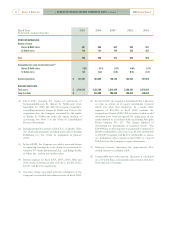Barnes and Noble 2005 Annual Report Download - page 17
Download and view the complete annual report
Please find page 17 of the 2005 Barnes and Noble annual report below. You can navigate through the pages in the report by either clicking on the pages listed below, or by using the keyword search tool below to find specific information within the annual report.
[MANAGEMENT’S DISCUSSION AND
ANALYSIS OF FINANCIAL CONDITION AND RESULTS
OF OPERATIONS continued ]
16
2005 Annual ReportBarnes & Noble, Inc.
SEASONALITY
The Company’s business, like that of many retailers, is
seasonal, with the major portion of sales and operating
profit realized during the fourth quarter which includes
the holiday selling season.
LIQUIDITY AND CAPITAL RESOURCES
Working capital requirements are generally at their
highest in the Company’s fiscal quarter ending on or
about January 31 due to the higher payments to vendors
for holiday season merchandise purchases. In addition,
the Company’s sales and merchandise inventory levels
will fluctuate from quarter to quarter as a result of the
number and timing of new store openings.
Cash and cash equivalents on hand, cash flows from
operating activities, funds available under its senior
credit facility and short-term vendor financing continue
to provide the Company with liquidity and capital
resources for store expansion, seasonal working capital
requirements and capital investments.
Cash Flow
Cash flows provided from operating activities were
$499.7 million, $532.4 million and $471.3 million
during fiscal 2005, 2004 and 2003, respectively. In
stockholders of record as of the close of business on
November 2, 2004. As a result of the Stock Sale and
the Spin-Off, GameStop is no longer a subsidiary of the
Company and, accordingly, the Company will present
all historical results of operations of GameStop as
discontinued operations.
Earnings
As a result of the factors discussed above, the
Company reported consolidated net earnings of $143.4
million (or $1.93 per share) during fiscal 2004
compared with net earnings of $151.8 million (or
$2.07 per share) during fiscal 2003. Components of
diluted earnings per share (EPS) are as follows:
Fiscal Year 2004 2003
EPS from continuing operations
(a) $ 1.68 1.57
EPS from discontinued operations
0.25 0.50
Consolidated EPS
(a) $ 1.93 2.07
(a) Includes a one-time charge of $0.11 per share associated
with the redemption of the convertible notes in fiscal
2004.
fiscal 2005, the decrease in cash flows from operating
results was primarily due to the timing of rent
payments. In fiscal 2004 and 2003, the increase in cash
flows from operating activities was primarily
attributable to improved working capital management
and an increase in net earnings.
The weighted-average age per square foot of the
Company’s 681 Barnes & Noble stores was 7.7 years as
of January 28, 2006 and is expected to increase to
approximately 8.2 years by February 3, 2007. As the
Barnes & Noble stores continue to mature, and as the
number of new stores opened during the fiscal year
decreases as a percentage of the existing store base, the
increasing operating profits of Barnes & Noble stores
are expected to generate a greater portion of the cash
flows required for working capital, including new store
inventories, capital expenditures and other initiatives.
Capital Structure
Strong cash flows from operations and a continued
emphasis on working capital management strengthened
the Company’s balance sheet in fiscal 2005.
On June 17, 2005, the Company, together with certain
of its subsidiaries, entered into a Credit Agreement (the
New Facility) with a syndicate led by Bank of America,
N.A. and JPMorgan Chase Bank, N.A. The New
Facility replaces the Amended and Restated Credit and
Term Loan Agreement, dated as of August 10, 2004
(the Prior Facility), which consisted of a revolving credit
facility and a term loan. The revolving credit facility
portion was due to expire in May 2006 and the term
loan had a maturity date of August 10, 2009. The Prior
Facility was terminated on June 17, 2005, at which time
the prior outstanding term loan of $245.0 million was
repaid. Letters of credit issued under the Prior Facility,
which totaled approximately $30.0 million as of June
17, 2005, were transferred to become letters of credit
under the New Facility.
The New Facility provides for a maximum aggregate
borrowing amount of $850.0 million (which under
certain circumstances may be increased to $1.0 billion
at the option of the Company) and terminates on June
16, 2010. The maximum aggregate borrowing amount
may be reduced from time to time according to the
terms of the New Facility. Borrowings made pursuant to
the New Facility may be committed loans or swing line
loans, the combined sum (including any outstanding
letters of credit) of which may not exceed the maximum
borrowing amount.
























